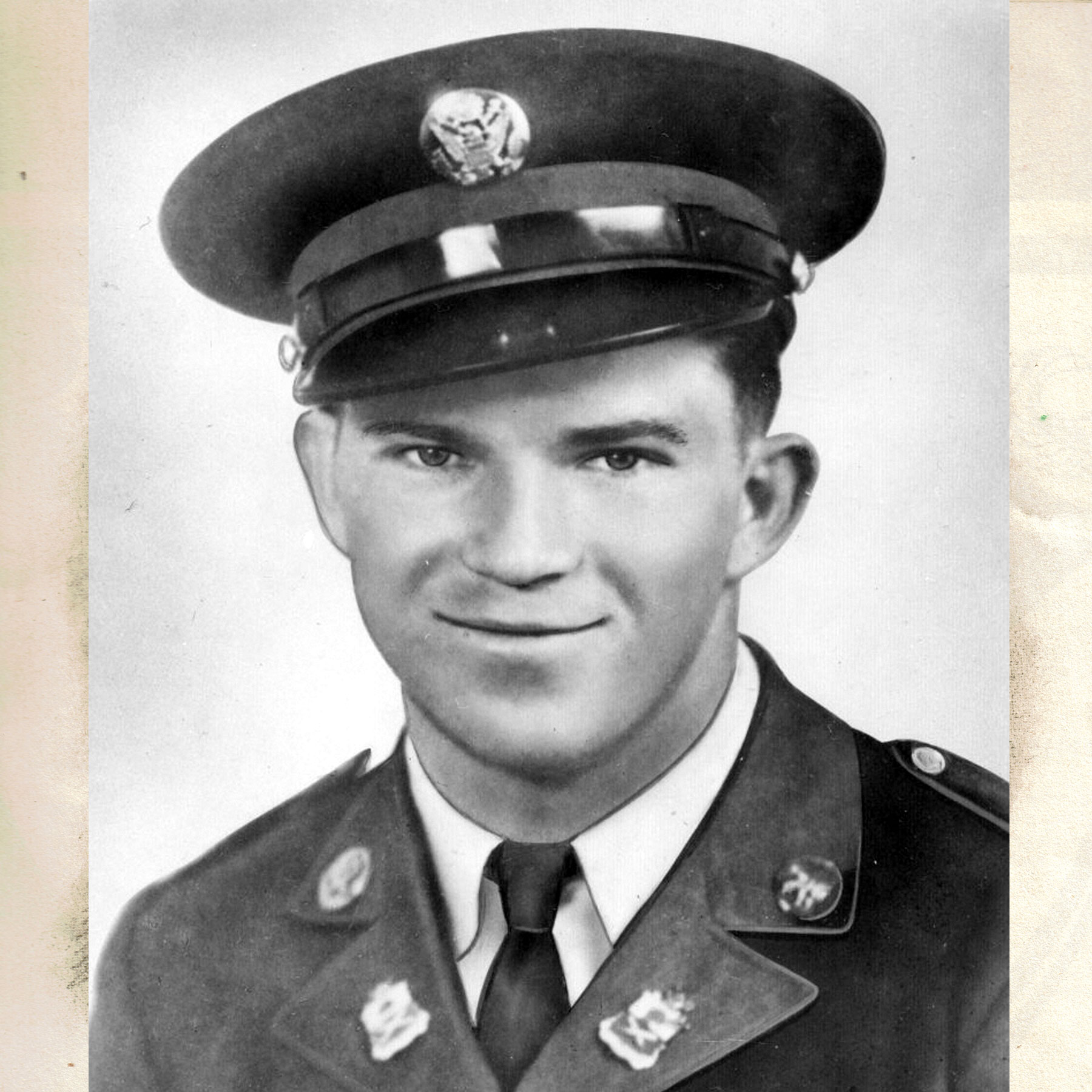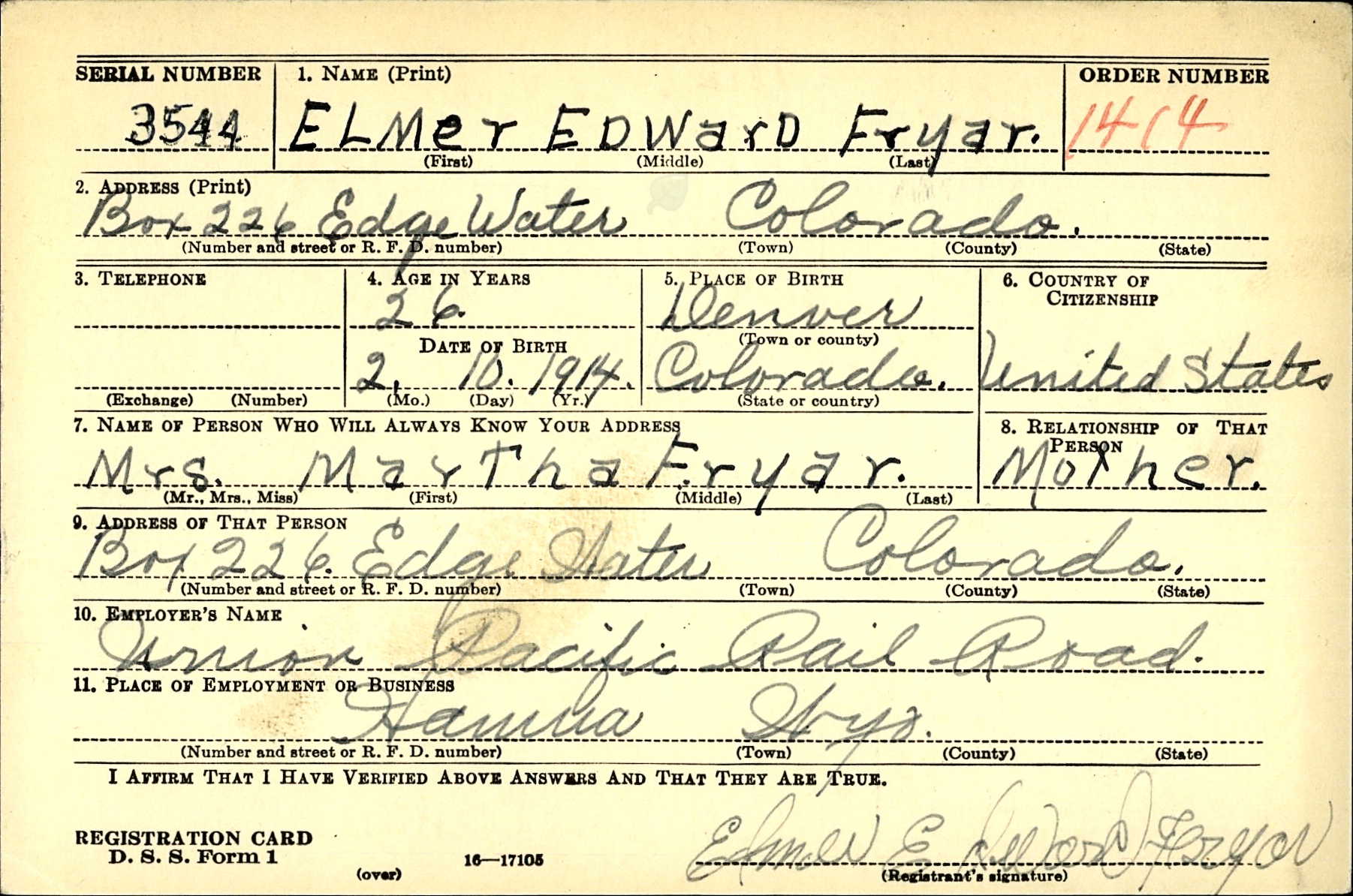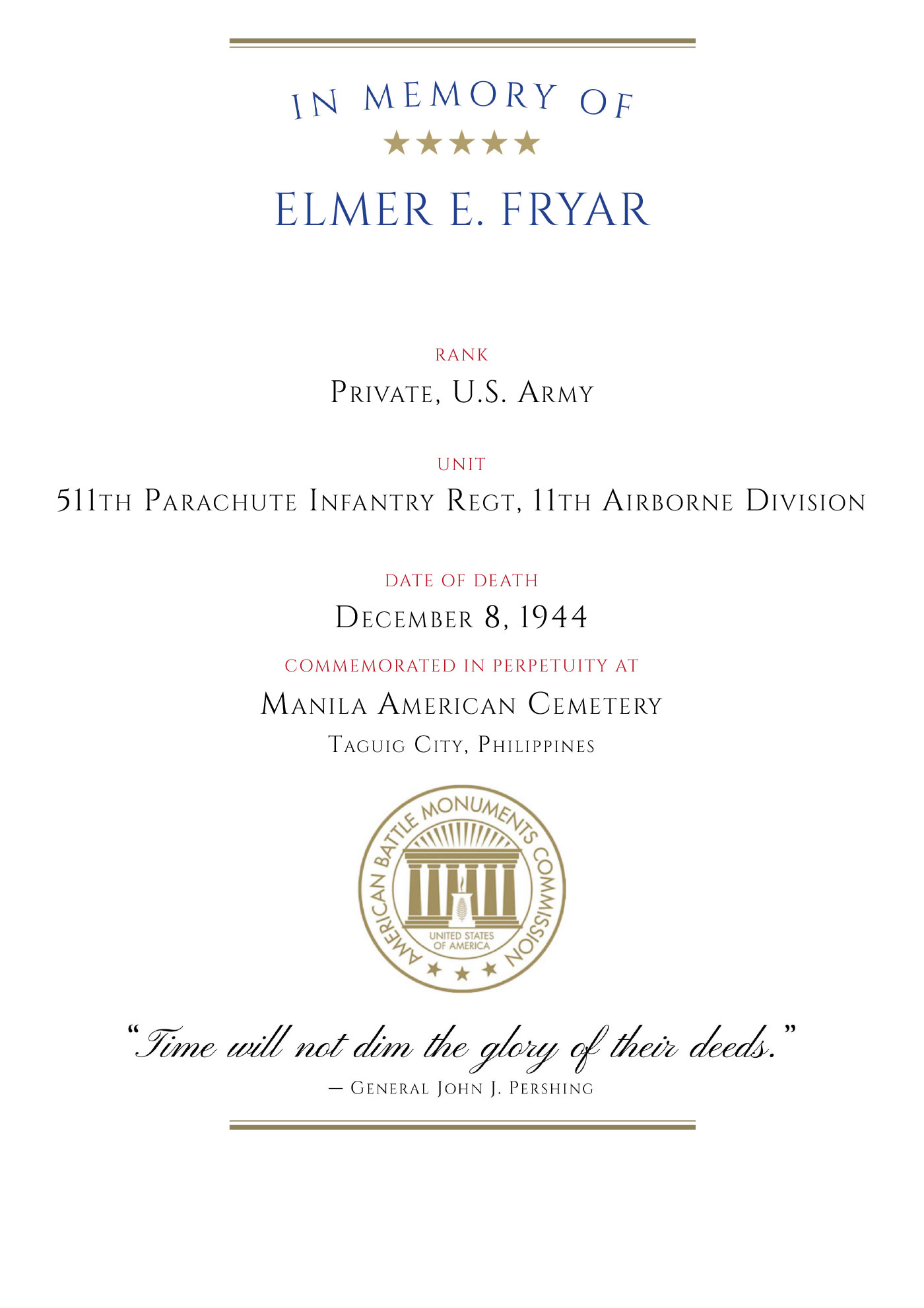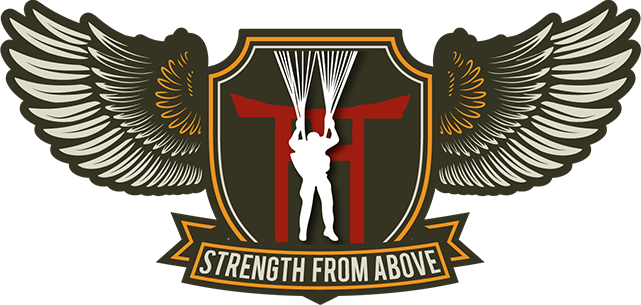Pvt. Fryar, Elmer E.

E Company, 511 PIR - KIA
02/10/14 - 12/08/44 (Age 30) - gravesite
Citations: Medal of Honor, Bronze Star, Combat Infantryman Badge, Purple Heart with oak leaf device, Parachutist Badge
Locations: Camp Toccoa, Camp Mackall, Camp Polk, Camp Stoneman, New Guinea, Leyte
Elmer Edward Fryar (39325592) was born on February 10, 1914, in Denver, Colorado to George Franklin Fryar (age 30) and Martha Mary Mathews (Fryar) (age 24). The family, including Elmer's older brother Donald and sister Dorothy, later moved to Maple Grove then Edgewater, Colorado. At some point Elmer's family moved back to Denver where they lived on 3913 Ocola Street.
Note: some sources mistakenly list Elmer's birthday as 1911, but his draft card correctly states that he was born in 1914. Also, Elmer was NOT 31 or 32 as some sources state; he was 30 years, 9 months, and 28 days.
Elmer attended Prospect Valley and Wheatridge High School, and was a farmer and coal miner prior to entering military service. At age eighteen, the 5' 6" Elmer joined the United States Army and served three years (1932-35) before leaving the service then joining the Marines in 1939 at age 25 for four years. Before World War II broke out, the 147-pound Elmer registered for the draft on October 16, 1940 then worked for the Union Pacific Railroad before volunteering for the parachutes in 1942. In January of 1943 he was assigned to Captain Hobart B. Wade's Company E, 511th Parachute Infantry Regiment at Camp Toccoa, Georgia (the 511th PIR would later become part of the 11th Airborne Division).
After a few months, Elmer and E Company were sent to Fort Benning's Jump School where he graduated and became a full-fledged paratrooper. Returning to Camp Mackall, North Carolina, the 511th PIR was involved in the historic Knollwood Maneuvers in December of 1943, then traveled to Camp Polk, Louisiana for more training and maneuvers.
On May 2, 1944, the regiment disembarked from Camp Stoneman, California for Dobodura, New Guinea where the 11th Airborne underwent theater training for several months before being committed to combat on the island of Leyte in November of 1944. Their main task was to head into the island’s mountains and destroy Japan’s main supply line while eliminating the enemy’s 16th and 26th Infantry Divisions.
After several weeks of intense combat, on December 7, 1944, 2/511 moved out westward toward Anas to cut the enemy supply trail. 2/511’s LTC Norman Shipley ordered E-511 under CPT Hobart Wade to remain behind for one day to act as battalion rear guard.
As dawn broke on December 8, 1944, a stirring E Company was startled when Japanese soldiers opened up with machine guns near Maloney Hill outside Mahonag. With bullets zipping through the banana trees over their heads, the paratroopers smoothly engaged, only to find that once again the enemy held the high ground.
"There was no call for anyone to do anything but sit in his foxhole and shoot along previously planned lanes of fire," one of the troopers noted later.
Considering it "a normal morning Banzai attack", when the enemy pressed in, thirty-year-old PVT Elmer E. Fryar (he was the oldest trooper in E Company) called in mortar bombardments and directed machine gun fire to break the first Banzai charge.
When an E Company trooper had his head "creased" by an enemy sniper, the dazed sergeant stood and began staggering towards the enemy line in confusion. PVT Fryar jumped up from his firing position behind a fallen log and rushed out to haul the stumbling sergeant back to safety as Japanese snipers continued to fire on them both.
Elmer also used his own M1 Garand rifle with devastating accuracy during the fierce assault, but when he noticed an enemy platoon of 40-50 trying to flank their position, Fryar quickly moved to the top of a ridge to reposition himself and opened fire, leaving at least 26 enemy dead around him. The survivors of the flanking enemy platoon withdrew, and Fryar’s buddies later noted that evidence indicated they had carried several other dead or wounded away before the official count of Elmer’s actions occurred.
As newspapers across the nation later described it, "(Fryar) fired fast and accurately. But he was drawing all the enemy fire on himself. During the fight he was hit in the left arm (above his tattoo) and shoulder, but that didn't stop Fryar."
E Co’s bloodied T/5 Neal A. Retherford of Wadsworth, Ohio, was near Fryar when the Japanese first attacked. He said, "I had been wounded by a hand grenade and was bleeding quite badly. Private Fryar was on the extreme right and he yelled and pointed out that the Japs were trying a flanking movement. There were between 40 and 50 of them"
.“(Fryar) and his machine gun gave us time to pull out and climb the steep bluff to safety,” noted SGT Wilbur Wilcox of D Company. “I think the whole battalion could have been wiped out.”
T/5 Retherford continued his account:
"Fryar went forward alone to the top of of a ridge and took up his position there to cover the withdrawal of the rest of the company. He opened up with his M1 rifle. There was a lot of firing and soon he came back and found me. He put a tourniquet on my arm and leg while the lead was flying all around us. He said he got plenty of them. He figured about half of them, anyway. He helped me down the trail and we met the lieutenant leading a wounded man."
The officer was West Point-graduate and regimental transportation officer 1LT Norvin L. "Stinky" Davis of Wells, Nevada and the wounded man was PFC Marvin D. Douglas of Oakville, Tennessee. Douglas later pointed out, "Fryar was wounded, too. I had been nicked by a Japanese .25 caliber bullet and the lieutenant was helping me. As we helped each other down the trail, the Jap jumped up from behind some bushes and aimed his rifle at the lieutenant. The other wounded man and I hit the ground, but Private Fryar moved past us and threw himself in front of the lieutenant."
1LT Norvin L. Davis noted that when the Japanese soldier rose from the bushes with rifle in hand, "I had no chance to move. But Private Fryar came from behind me and threw himself into the line of fire. There were seven bullet holes in his chest and stomach, but he drew a hand grenade as he fell to the ground and pulled the pin. He threw it and the Japanese was blasted all over the trail."
It was the twenty-seventh enemy Elmer killed that day. 1LT Davis added, "He died before aid could be brought to him. But as he lay there with a smile on his face, he asked us to write his to his folks and tell them he'd got a mess of Japs before they got him."
The next day, December 9, 1944, E Company remained engaged with the enemy in a creek bed and casualties were mounting, including 2LT Robert Norris who had been killed the day before (which explains why regimental transportation officer 1LT Davis had taken over the withdrawal). The Japanese launched another assault, and the fighting became hand to hand inside the Angels’ perimeter. Leyte’s mud turned red with blood as bayonets, knives, entrenching tools and even helmets were employed to hold the line.
1LT Davis said, "Our attack was successful, and we drove out the Japs. Around the position where Private Fryar had engaged the flanking attack, we found the bodies of 27 Japanese he had killed and evidence that the survivors had carried others away."
When my grandfather 1LT Andrew Carrico and D Company found E Company on December 10, they passed five seriously wounded Angels laying under poncho tarps while their comrades (some of whom were also wounded) shivered in wet foxholes. D Company's Stephen Cavanaugh told E Company’s pipe-smoking CPT Hobart B. Wade of LaFeyette, GA, that D Company would cover their extraction. Wade was a legend in the regiment (and in the airborne community) as he had been the platoon sergeant in America’s original Parachute Test Platoon in 1940.
D Company moved into vacated foxholes as E Company began withdrawing under fire. D Company's S/Sgt. Wilbur Wilcox remembered, "The Japs climbed trees around the area and began picking off the E Company men in their foxholes. (They) threw more grenades that day than any other time I can remember. I believe (E Company) would have been annihilated, if we had been unable to reach them."
PVT Elmer Fryar's valiant stand two days earlier would posthumously earn him the 11th Airborne Division's first Medal of Honor on May 4, 1945 (at age 30, Elmer was the oldest American paratrooper to earn the medal in World War II). He was later awarded the Silver Star on June 20, 1945, by US Sixth Army's General Walter Krueger.
His Medal of Honor was later presented to Elmer's parents on May 12, 1945, in Denver, Colorado by MG Willam A. Danielson. Elmer's father Franklin said that Elmer "always loved adventure and he probably was having the time of his life before he was killed on Leyte."
 For reasons lost to history, PVT Fryar’s remains were recovered from the 511th PIR's cemetery on Rock Hill outside Mahonag, but Elmer's body was then "lost in recovery." He is listed with 36,286 of his comrades on the Tablets of the Missing at the Manila American Cemetery on Luzon situated on grounds that his fellow paratroopers later liberated. Today the Fryar Field Drop Zone at Fort Benning is named for the Angel who stood and immoveable made the ultimate sacrifice for his friends, as is the Elmer E. Fryar US Army Reserve Center located in Denver, Colorado. There is also an Elmer-Fryar-Ring in Stadtbergen, Germany.
For reasons lost to history, PVT Fryar’s remains were recovered from the 511th PIR's cemetery on Rock Hill outside Mahonag, but Elmer's body was then "lost in recovery." He is listed with 36,286 of his comrades on the Tablets of the Missing at the Manila American Cemetery on Luzon situated on grounds that his fellow paratroopers later liberated. Today the Fryar Field Drop Zone at Fort Benning is named for the Angel who stood and immoveable made the ultimate sacrifice for his friends, as is the Elmer E. Fryar US Army Reserve Center located in Denver, Colorado. There is also an Elmer-Fryar-Ring in Stadtbergen, Germany.
As the official citation for his Medal of Honor states (full text at bottom):
"Private Fryar's indomitable fighting spirit and extraordinary gallantry above and beyond the call of duty contributed outstandingly to the success of battalion's withdrawal and its subsequent attack and defeat of the enemy. His heroic action in unhesitatingly giving his own life for his comrade in arms exemplifies the highest tradition of the Armed Forces of the United States."
Elmer Fryar: An Angel's Story - Medal of Honor Recipient in World War II
Elmer Fryar's full citation for the Medal of Honor:
GENERAL ORDERS:
War Department, General Orders No. 35, May 9, 1945
CITATION:
The President of the United States of America, in the name of Congress, takes pride in presenting the Medal of Honor (Posthumously) to Private Elmer E. Fryar (ASN: 39325592), United States Army, for conspicuous gallantry and intrepidity at the risk of his life above and beyond the call of duty on 8 December 1944, while serving with Company E, 511th Parachute Infantry Regiment, 11th Airborne Division, in action at Leyte, Philippine Islands. Private Fryar's battalion encountered the enemy strongly entrenched in a position supported by mortars and automatic weapons. The battalion attacked, but in spite of repeated efforts was unable to take the position.
Private Fryar's company was ordered to cover the battalion's withdrawal to a more suitable point from which to attack, but the enemy launched a strong counterattack which threatened to cut off the company. Seeing an enemy platoon moving to outflank his company, he moved to higher ground and opened heavy and accurate fire. He was hit, and wounded, but continuing his attack he drove the enemy back with a loss of 27 killed.
While withdrawing to overtake his squad, he found a seriously wounded comrade, helped him to the rear, and soon overtook his platoon leader, who was assisting another wounded. While these four were moving to rejoin their platoon, an enemy sniper appeared and aimed his weapon at the platoon leader. Private Fryar instantly sprang forward, received the full burst of automatic fire in his own body and fell mortally wounded. With his remaining strength he threw a hand grenade and killed the sniper. Private Fryar's indomitable fighting spirit and extraordinary gallantry above and beyond the call of duty contributed outstandingly to the success of the battalion's withdrawal and its subsequent attack and defeat of the enemy. His heroic action in unhesitatingly giving his own life for his comrade in arms exemplifies the highest tradition of the U.S. Armed Forces.


As a last note, donations can be made for the scholarship established to honor the legacy of Elmer E. Fryar (MOH) at Metropolitan State University of Denver. Checks can be sent to the MSU Denver Foundation, PO Box 17971, Denver, CO 80217-9812. Please note "Elmer E. Fryar (MOH) Memorial Endowed Scholarship" on the memo line of your check. For more information about the fund, contact Chrysti Britt, associate director of development, at 303-556-5115 or crowden@msudenver.edu.
To learn more about the 11th Airborne Division in World War II, please consider purchasing a copy of our books on the Angels:


